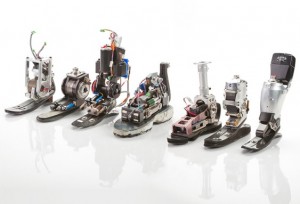Practices of High-Performance
BxD 1.1 Biomechatronics

When you enter the Media Lab building on the campus of MIT you are presented with a gallery of objects that have been designed there. At my last visit, a section of the floor was devoted to showcasing the prosthetic devices – bionic limbs – created in the Lab of Hugh Herr. Not one of these devices resembles the Jaipur Leg, the beige apparatus that many people associate with artificial limbs. Instead, even the early examples of Herr’s devices, now decades old, look futuristic. Built with a desire to restore mobility to the wearer rather than to disguise the loss of a body part, Herr’s devices redefine what it meant to have an artificial limb.
The Jaipur Leg, initially invented and refined in the late 1960s and early 1970s, was a 20th century interpretation of a 3,000 year old quest. Prosthetic devices since the days of ancient Egypt have emphasized the cosmetic concerns of the wearer. From the Cairo Toe to the Jaipur Leg, inventors of artificial body parts have attempted to mimic the look of the body.
While the Jaipur Leg approximated the form of the body, Herr’s devices deliver the function of the body parts they replace. Using a complex combination of metal, fiberglass, and other materials Herr’s artificial knees, ankles, and feet produce movement and balance similar to their biological forebears. In some cases, Herr’s devices do not just replace lost function; they also can enhance function enabling their wearers to do things people with biological legs and feet cannot.
Before dismissing the Jaipur Leg as antiquated technology, it warrants consideration as an important designed object. As UNICEF explains, the Jaipur Leg is the world’s least expensive prosthetic limb, costing about $45. Moreover, it is constructed and repaired with easily-obtainable materials by local artisans in economically-challenged regions around the world. The Jaipur Leg solves real problems in sustainable ways – at the time of its creation and today. And it is not hard to imagine its designers empathizing with users – the people in need of artificial limbs – as they developed their device.
Of course, we cannot know fully the intentions or experiences of the designers of the Jaipur Leg (much less the Cairo Toe). However, because the final devices resemble the original body parts, it may be reasonable to assume that the design was influenced by an empathy for the self-consciousness of wearers. If so, one can imagine designers striving to create increasingly lifelike devices to fool the eye. In fact, the effort to produce look-alike replicas has shaped the design of artificial limbs for centuries.
Such a design trajectory raises questions about our enduring cultural beliefs about different bodies. Are different bodies lesser bodies; bodies that should conceal their differences at least superficially through prosthetic devices? Or are different bodies simply different: meaning that the role of prosthetic devices is not to camouflage difference but to supply wearers restored or enhanced levels of autonomy.
Question: What if we reframed human limitation as human potential in the creation of innovations routinely? Share your stories of doing so with us. (Note: Submissions may not be posted in their entirety, and not all submissions will be posted.)